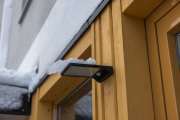With the advent of LED technology more attention needs to be paid to the way light fittings are controlled. Switching LEDs is very straightforward but dimming is a bit more complicated. There are different ways of dimming (see below for the different dimming types) and the type of LED Driver needs to be matched to the control system in use. It is also recommended to test drivers and dimmers together; even if theoretically compatible, they aren’t always so in practice. We ensure that the fittings and drivers we supply work together well.
Dedicated LED lighting (i.e. not retrofit lamps) isn’t generally compatible with the rotary type resistive dimmers commonly installed in residential properties. These legacy dimmers will need to be replaced with an alternative system to facilitate dimming.
Different dimming types
Switched mains (non dimming)
If you don’t need to dim your LED fitting then this is the driver type to choose. These drivers will work with conventional on / off light switches or lighting control systems.
Mains dimming (leading edge)
This method of dimming is most commonly used for Electronic Low Voltage transformers typically used for Halogen lamps. Rarely used for LED fittings and frequently troublesome with LED. No control cable is required.
Built-in dimmers
There are two types of built-in dimmers: rotary or push button.
A rotary knob dimmer can be pressed to turn lights on or off. You turn the knob to select the light intensity.
A push button works according to the same on-off principle. However, to change the light intensity, you must hold in the button. Some push button dimmers alternate in their operation (brightness increases during the first long press, dimming occurs during the second long press). Other push button dimmers reach a specific percentage (brightness increases to an specific intensity when N percent is reached and then dims again).
0–10V vs 1–10V dimming
What are they for
Dimming LED or fluorescent lights.
How does it work
0–10V
A 0–10V dimming driver sends a low DC voltage signal to the fluorescent ballast or LED driver. The lighting changes as the voltage is varied.
So, at zero volts the light will dim to 0% and turn off. At 10 volts the system is operating at 100% and the light will be fully on.
1–10V
It works in a similar fashion to 0-10v dimming, but the voltage is ‘sinked’ by the driver and will only go as low as 10% before the power to the circuit needs to be physically switched off. This method provides a very smooth dimming curve which is especially useful for colour changing LEDs.
Things you should know:
0–10V and 1–10V are:
analogue—the lighting changes according to controlled variations in voltage
hardwired—each device needs its own wiring, which makes installation quite tricky if the lighting control system is large and complex
unidirectional—data goes only one way, from the dimming driver to the LED driver or fluorescent ballast. Because there’s no signal coming back from the lights, there’s no data on which to measure their performance, as with digital systems
A 0–10V system can accommodate around 10 luminaires per controller.
DALI (Digital Addressable Lighting Interface)
What is it for
Lighting control for LED, fluorescent, halogen or incandescent lights.
How does it work
A DALI ballast receives voltage through one pair of wires, while another pair relays a digital signal from the controller devices (e.g. a dimmer) to the luminaires.
In a DALI network, each ballast and relay switch is assigned a unique address to which commands can be sent. This allows the system to be controlled from web-based software installed on a PC.
Things you should know
DALI is:
digital—meaning the system can dim lights to much more precise levels of brightness
bidirectional—the two-way communication between the DALI ballast and luminaires means the system can diagnose issues and relay feedback and data to the user interface (i.e. PC software)
open—because it isn’t a proprietary technology, it’s available from many different suppliers worldwide and can be used alongside devices from other manufacturers
The DALI protocol is useful if luminaires need to respond to more than one input device (such as a wall switch and a daylight sensor).
As with 0–10V dimming, DALI requires a lighting control cable, but the cable can be run between many fittings. In fact, one DALI network can accommodate up to 64 DALI ballasts.
DALI allows lighting controls to operate as stand-alone systems or be integrated into larger building management systems.
DMX
DMX is commonly used for colour programmable fittings. The DMX signal is generated by a lighting control system and requires dedicated cabling between the controller and driver. DMX is generally used with professionally designed lighting control systems.
Understanding the different dimming types is critical to the success of any lighting project. As part of our lighting design service we can supply lighting control systems with matched drivers and dimmers; if you have any needs or questions, please contact us.






